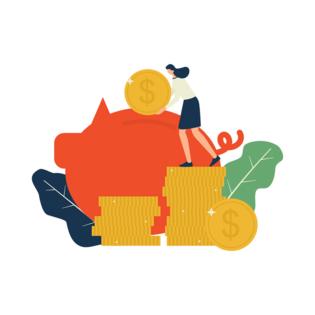How to start saving (even if you're starting from scratch)
Published in Lifestyles
Saving money can feel like an uphill battle, especially when you’re starting from zero. But here’s the good news: No matter how small your bank balance, it’s never too late to start building your savings. With the right mindset, tools, and strategies, you can transform your financial future one dollar at a time.
About 4 in 10 U.S. adults (44%) could cover the cost of a $1,000 emergency with savings, according to Bankrate’s recent annual emergency savings report.
You might think you need to make more money in order to save, but there are actually plenty of other ways you can start your nest egg today rather than tomorrow. Here are seven tips.
1. Set clear savings goals
The key to successful saving? Knowing what you’re saving for. Whether it’s an emergency fund, a down payment on a house, or a dream vacation, having specific goals can keep you motivated and on track.
Start by writing down your savings goals, giving them names (like “new car” or “wedding”), and setting deadlines for when you want to achieve them. Then, calculate how much you need to save each month to reach your target amount by your deadline.
2. Create a budget that works for you
Budgeting doesn’t have to be scary. At its core, a budget is simply a plan for making sure you’re spending less than you earn. While spreadsheets can be helpful, the key is finding a budgeting method that works for your lifestyle and personality.
One popular approach is the 50/30/20 rule. Here’s how it works:
•50% of your income goes to needs (like housing, food, and health care)
•30% goes to wants (like dining out, hobbies, and streaming services)
•20% goes to savings and debt repayment
To get started, track your income and expenses for a month, then categorize them into needs, wants, and savings. If your spending doesn’t align with the 50/30/20 split, look for areas where you can cut back or adjust.
Another helpful strategy is the 30-day rule. Before making any non-essential purchases, wait 30 days. This gives you time to assess whether the item is truly worth the cost and can help curb impulse buying.
3. Tackle high-interest debt
High-interest debt, like credit card balances, can be a major obstacle to saving. According to a recent Bankrate survey, over half of American credit cardholders carry a balance from month to month, with APRs often ranging from 20 to 30%.
Let’s say you have a $5,000 credit card balance with a 25% APR. Even if you pay $300 per month, you’ll end up paying an extra $1,579 in interest before reaching a zero balance. That’s money that could be going into your savings instead.
While it might not feel like paying off debt is helping you save, eliminating those costly interest charges can free up more money to put toward your goals in the long run.
4. Build your emergency fund
Life has a way of throwing curveballs when we least expect them. Whether it’s a car repair, a medical bill, or a job loss, having an emergency fund can help you weather financial storms without derailing your savings progress.
Aim to save enough to cover 3-6 months’ worth of essential expenses in a separate, easily accessible account. Start small if you need to, even if it’s just $50 or $100 a month. The important thing is to make saving for emergencies a regular habit.
5. Automate your savings
One of the easiest ways to save more consistently? Make it automatic. Set up recurring transfers from your checking account to your savings account each payday, so you’re saving without even thinking about it.
Many banks also offer tools like round-up programs, which automatically round your debit card purchases to the nearest dollar and transfer the spare change to your savings. Over time, those small amounts can really add up.
You can also take advantage of money-saving apps like Digit or Qapital, which can analyze your spending habits and automatically move small amounts of money into your savings when you can afford it.
6. Separate your spending and saving
If you struggle with the temptation to dip into your savings for impulse purchases, consider keeping your checking and savings accounts at separate banks. This creates a psychological barrier between your spending money and your savings, making it less likely you’ll raid your savings on a whim.
“When you open your bank account app and your checking and savings numbers are in there, you kind of add those numbers together, and you’re like, ‘Oh, that’s how much money I have to spend,'” says Pamela Capalad, a certified financial planner and owner of Brunch & Budget. “But if they are totally separate, you kind of forget.”
7. Find extra money to save
Saving more doesn’t always mean earning more. Take a close look at your spending habits and see if there are any areas where you can cut back, like subscriptions you don’t use or impulse purchases you later regret.
If combing through your expenses sounds tedious, try temptation bundling — pairing a task you don’t enjoy with a reward you do enjoy. For example, only listen to your favorite podcast while reviewing your budget and canceling unused subscriptions.
“You create a way to reward yourself for doing an unpleasant but important activity,” says Mariel Beasley, co-director of Common Cents Lab, a financial research lab at Duke University.
You can also look for extra cash streams to boost your savings, like a side hustle, selling unused items, or depositing gift money directly into your savings account.
The bottom line
Starting to save can feel daunting, but the most important thing is to just start. No amount is too small, and no goal is too insignificant. By setting clear goals, creating a budget, tackling debt, and automating your savings, you can build a solid financial foundation one dollar at a time.
Remember, everyone’s financial journey is different. Stay open to trying new strategies and tools until you find the ones that work best for your unique situation and personality. With persistence and creativity, you can turn saving from a chore into a rewarding habit that pays off for years to come.
Key takeaways
•The first step to saving is setting specific, achievable goals and tracking your progress using multiple savings accounts or digital budgeting tools.
•Creating a budget using the 50/30/20 rule can help you balance your spending and saving, while the 30-day rule can curb impulse purchases.
•Paying off high-interest debt, like credit card balances, is crucial to building a strong foundation for your savings.
•Building an emergency fund should be a top priority to protect your finances from unexpected expenses.
•Automating your savings, using money-saving apps and keeping your checking and savings accounts at separate banks can help you save more consistently.
©2025 Bankrate.com. Distributed by Tribune Content Agency, LLC.
























Comments